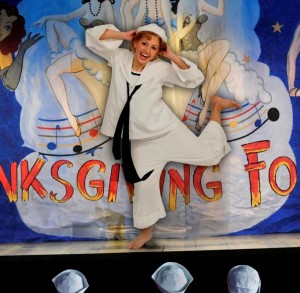Fuse Theater Review: South Pacific Endures
South Pacific endures in this production (and will in others) because it centers on two love stories that are “lovely beyond description.”
South Pacific. Music by Richard Rodgers, Lyrics by Oscar Hammerstein II. Book by Hammerstein and Joshua Logan. Directed by Sarna Lapine. Presented by Broadway in Boston at the Opera House, Boston, MA through October 2.
By Michela Smith.
Before the latest national touring production of Rodgers & Hammerstein’s South Pacific opened in Boston last night, the opening lines of James A. Michener’s Tales of the South Pacific were projected on the scrim curtain: “I wish I could tell you about the South Pacific. The way it actually was . . . lovely beyond description . . . But whenever I talk about the South Pacific, people intervene.” They were printed in nostalgic Courier New, the lines faded into the yellow of the curtain’s “parchment” as if were fading from memory.
Perhaps the image expressed sadness about the waning of The Greatest Generation. Or it admitted the fear of some that this heralded musical may no longer be as powerful as when it premiered in 1949, garnering a 1950 Pulitzer Prize and 10 Tony Awards. There have been many touring productions as well as the 1958 Rossano Brazzi/Mizi Gaynor Hollywood film. At this point, in the 21st century, could the heralded Broadway triumph about prejudice be dated?
The Lincoln Center revival in 2008 proves otherwise—it harvested seven Tony Awards. Now the production is touring with the original New York cast, and when the overture began, all fears of creaky nostalgia are banished: on the wings of Rodgers score (“There is Nothing’ Like a Dame,” “Younger than Springtime,” “Bali Hai,” Gonna Wash that Man Right outa my Hair,”and “Some Enchanted Evening”) the show’s tropical ocean breezes refreshed just as before.
The play’s conflict remains as powerful as ever: Ensign Nellie Forbush must choose to accept the simplicity of love amid the chaos of world war. Actress Katie Reid evokes the confident naivety essential for putting Nellie across; her singing voice exudes the sweet clarity of a Julie Andrews. The stoic masculinity of Emile de Becque (Marcelo Guzzo) lures many female audience members (at least those at the opening night performance) into dreaming of snuggling into the safety of his broad shoulders. Guzzo’s deep, operatic tenor beautifully contrasts with Reid’s fragile beauty and voice. The endearing hilarity of Luther Billis’s Seabees (Christian Marriner & company) provides the comedic contrast to the deadly severity of war.
Still, the musical’s message of tolerance and its criticism of American racial prejudice shook contemporary American audiences when it premiered. While South Pacific‘s bravery can be appreciated in retrospect, its impact as an attack on social attitudes cannot be replicated now. The show’s preaching comes off as bit safe and sound today.
That being said, the production looked anything but antique. Michael Yeargan’s and Mikiko Suzuki MacAdams’s set design made the stage action feel contemporary rather than an aged picture postcard. Giant scrim maps of the Pacific theatre during military planning scenes set the audience in the middle of the action. Border curtains made out of wooden slats to mimic island windows made us feel like we were a part of the action. An adroit use of 3-D sets, like the shower houses and Thanksgiving-show-stage, shrunk the space between the audience and performers.
But above all other contemporary additions, South Pacific endures in this production (and will in others) because it centers on two love stories that are “lovely beyond description.” Love stories that combat prejudices and war itself to survive. Love stories that have, and will, survive in memory, even if they fade in and out with time.


